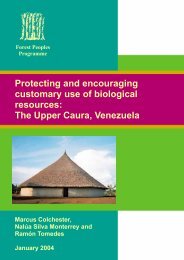Divers Paths to Justice - English - Forest Peoples Programme
Divers Paths to Justice - English - Forest Peoples Programme
Divers Paths to Justice - English - Forest Peoples Programme
Create successful ePaper yourself
Turn your PDF publications into a flip-book with our unique Google optimized e-Paper software.
<strong>Divers</strong> <strong>Paths</strong> <strong>to</strong> <strong>Justice</strong>: Legal pluralism and the rights of indigenous peoples inSoutheast AsiaReasonableness of the practice is an important foundation. What isreasonable is often measured against the behaviour and practices of thosewithin the area in which it operates. For instance, the Malay system ofcus<strong>to</strong>mary land tenure which provided for the payment of a tithe wasapproved as being ‘good and reasonable cus<strong>to</strong>m’. It was upheld by theCourt of Judicature in Sahrip v Mitchell & Anor. 20 The claimants had a right<strong>to</strong> the land in question simply because the cus<strong>to</strong>m or local law gave it <strong>to</strong>them.Given these guidelines, under <strong>English</strong> law, cus<strong>to</strong>ms are a question of factwhich must be proven. This raises the question; how should cus<strong>to</strong>ms beproven and the rights based on native laws and cus<strong>to</strong>ms therebyestablished?Proof of native laws and cus<strong>to</strong>ms: “s<strong>to</strong>ries matter”The question of proof and the treatment of oral his<strong>to</strong>ries of indigenouspeoples by the courts is endemic <strong>to</strong> native cus<strong>to</strong>mary land rights andaboriginal rights litigation generally. Cus<strong>to</strong>ms may be proven or establishedby reference <strong>to</strong> writers on indigenous law, public records, village oraltraditions and the opinion of persons likely <strong>to</strong> know of the existence of suchtraditions. Even in using the works of writers, there have been voicescautioning against text books and old authorities which tend <strong>to</strong> viewindigenous law through the prism of legal conceptions that are foreign <strong>to</strong> it.Courts may also be confronted with conflicting views on what cus<strong>to</strong>marylaw is exactly. In the case of Angu v Attah, 21 Sir Arthur Channel said analleged rule of cus<strong>to</strong>mary law must be ‘proved in the first instance bycalling witnesses acquainted with the native cus<strong>to</strong>m until the particularcus<strong>to</strong>ms have, by frequent proofs in the courts, become so no<strong>to</strong>rious that the20 (1877) Leic Reports 466. The introduction of <strong>English</strong> law through the Charter of<strong>Justice</strong> did not supersede that cus<strong>to</strong>m any more than it superseded cus<strong>to</strong>ms inEngland.21 Angu v Attah (1916) PC Gold Coast 1874–1928, 4347
















